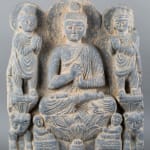Gandhara Schist stone relief of Buddha and disciples, 200 CE - 500 CE
Schist stone
CB.3397
Further images
Gandhara’s geographical position, situated between the Persian world to the west and the Indian to the east, ensured that it was open to a wide variety of artistic influences. Often...
Gandhara’s geographical position, situated between the Persian world to the west and the Indian to the east, ensured that it was open to a wide variety of artistic influences. Often described as a ‘cultural melting pot,’ its strategic importance left it vulnerable to attack. Briefly in the hands of Alexander the Great between 327 -326 B.C., Greek artistic conventions long played an important role in local production. However whilst Gandhara clearly came under the influence of an extraordinary wide range of outside influences, it was also an exporter of ideas. This is most apparent in relation to the spread of Buddhism from India into other parts of Asia. Gandharan monks and scribes were particularly active in areas of China. According to tradition Buddhism was first introduced into the Gandharan region under the patronage of Asoka, emperor of the Mauryan dynasty, in the third century B.C. The first significant physical remains to survive, including stupas and figurative sculpture, date from the first century B.C. Between c.100-400 A.D. sculptors working in schist, terracotta and stucco produced an astonishing number and variety of Buddhist images.
The Buddha is depicted sitting on a lotus pedestal with his legs crossed, and his hands are in dharmacakra mudra, the gesture of turning the wheel of dharma, which symbolises Buddhist teaching and preaching. Unlike the conventional soothing smile, the Buddha has a serious facial feature, since he is enunciating the adamant and solemn doctrines of Buddhism. Standing by his sides are two accomplished disciples, holding their hands together while listening to their master’s teachings in a pious and respectful manner. The halos and lotus pedestals of the three figures, which testify to the spiritual attainment of the Buddha and the two principal disciples, remain intact. Underneath the Buddha, two devotees bow before him beside the lotus pedestal. Likewise, a pair of guardian animals sit vigilantly under the accomplished disciples. This form of “1+2” mode of depicting a master flanked by two disciples is inherited all across Buddhist Asia and has been adopted as an artistic norm.
The Buddha is depicted sitting on a lotus pedestal with his legs crossed, and his hands are in dharmacakra mudra, the gesture of turning the wheel of dharma, which symbolises Buddhist teaching and preaching. Unlike the conventional soothing smile, the Buddha has a serious facial feature, since he is enunciating the adamant and solemn doctrines of Buddhism. Standing by his sides are two accomplished disciples, holding their hands together while listening to their master’s teachings in a pious and respectful manner. The halos and lotus pedestals of the three figures, which testify to the spiritual attainment of the Buddha and the two principal disciples, remain intact. Underneath the Buddha, two devotees bow before him beside the lotus pedestal. Likewise, a pair of guardian animals sit vigilantly under the accomplished disciples. This form of “1+2” mode of depicting a master flanked by two disciples is inherited all across Buddhist Asia and has been adopted as an artistic norm.







